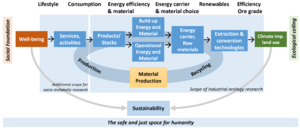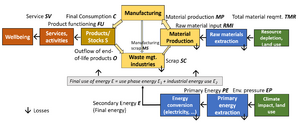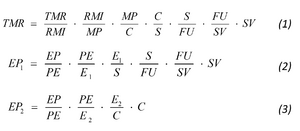STYLIE: Difference between revisions
(Add model equations) |
|||
| Line 2: | Line 2: | ||
=== Introduction === | === Introduction === | ||
[[File:SFS Nexus Doughnut-2048x886.png|thumb|The big-picture framework for industrial ecology and socio-metabolic research: The material and energy service cascade and the service-stock-flow nexus in the doughnut economy.]] | |||
In industrial ecology and socio-metabolic research, we operationalise the doughnut economy framework by adding the different steps of the so-called energy and material service cascade, which is a cascade of system couplings, including the following links: services (like transport, thermal comfort) to wellbeing, functions (car driving, building heated) to services, products (cars, houses) to functions, energy and material to build products, energy and material to operate products, energy carriers and raw materials, resource extraction and energy conversion technologies, and the impact of all these activities on the environment (see Figure below and check [https://www.blog.industrialecology.uni-freiburg.de/index.php/2018/12/02/why-a-two-pillar-model-is-a-better-choice-for-conceptualizing-sustainability/ here] for details). Central in the energy service cascade is the so-called stock-flow service nexus, which is comprised of the blue boxes ‘services/activities’, ‘functions’, ‘products/stocks’, and build-up and operational energy and material flows. This nexus is an important system linkage in society’s metabolism, as it links energy and material flows to service provision for human wellbeing. | |||
STYLIE (from Stylistic industial ecology (IE) model) is a simple accounting tool to capture the major service flows, product stocks, and energy and material flows in a circular economy. It has a comprehensive scope, as it links service provision (a major constituent of human wellbeing) with envionmental pressures (such as resource extraction and climate impact). It's system definition, which is based on the concept of the energy service cascade is shown below. | STYLIE (from Stylistic industial ecology (IE) model) is a simple accounting tool for the energy and material service cascade, to capture the major service flows, product stocks, and energy and material flows in a circular economy. It has a comprehensive scope, as it links service provision (a major constituent of human wellbeing) with envionmental pressures (such as resource extraction and climate impact). It's system definition, which is based on the concept of the energy and material service cascade, is shown below. | ||
The main references for this system concept and the accounting model STYLIE are: | |||
* For the stock-flow-service nexus in the energy service cascade (system definition), see Bergsdal et al. (2007), DOI 10.1080/09613210701287588 // Kalt et al. (2019), DOI 10.1016/j.erss.2019.02.026 // Haberl et al. (2017), DOI 10.3390/su9071049 | |||
* For existing examples of the accounting equation, see the description of the IPAT equation (https://en.wikipedia.org/wiki/I_%3D_PAT) as well as the IE literature: Carmona et al. (2022), DOI 10.1016/j.egyr.2022.10.086 // Tanikawa et al. (2021), DOI 10.1016/j.jclepro.2020.125450 | |||
[[File:STYLIE 1.png|thumb|Figure: System definition of the STYLIE accounting model.]] | [[File:STYLIE 1.png|thumb|Figure: System definition of the STYLIE accounting model.]] | ||
| Line 10: | Line 16: | ||
STYLIE can be applied at any geographical, service sector, and material scale. As an accounting model, it does not generate new results, but uses results from existing scenarios to develop a set of indicators and show where in the energy service cascade the decoupling happens. | STYLIE can be applied at any geographical, service sector, and material scale. As an accounting model, it does not generate new results, but uses results from existing scenarios to develop a set of indicators and show where in the energy service cascade the decoupling happens. | ||
[[File:STYLIE 2.png|thumb|STYLIE accounting equations]] | [[File:STYLIE 2.png|thumb|STYLIE accounting equations]] | ||
The accounting equations of STYLIE (see figure on the right) follow the scheme of the | The accounting equations of STYLIE (see figure on the right) follow the scheme of the widely known IPAT accounting equation (https://en.wikipedia.org/wiki/I_%3D_PAT), as they expand the total pressure indicator into the different system variables, rearranging them to a decoupling factor for each stage in the energy service cascade. | ||
Each of the factors in the model equations has a distinct meaning. For example the variable <math>C/S</math> denotes the material consumption <math>C</math> needed to expand and maintain a given in-use stock <math>S</math>. The indicator raw material input <math>RMI</math> per material production <math>MP</math> describes the dependency of material production on natural resources, whereas its complement, the recycled content <math>SC/MP</math> is a salient CE indicator. | |||
The quantity <math>S/FU</math> denotes the in-use stock needed to deliver a certain function, such as heating of buildings and vehicle kilometers driven. It illustrates the intensity of use of products, vehicles, and buildings. | |||
To quantify the impact of CE strategies from a systems perspective, not only the implications for material use need to be looked at, but also the energy implications, as energy supply is a major driver of climate change and land use. Here, we use the energy accounting equations for energy use for operating products, vehicles, and buildings (use phase energy <math>E_1</math>) and the industrial energy use <math>E_2</math>. Salient indicators here are the GHG intensity of energy supply <math>EP/PE</math>, the energy intensity of the in-use stock <math>E_1/S</math>, and the energy intensity of material supply <math>E_2/C</math>. | |||
Next to the indicators listed in the equations, a number of other salient CE performance and impact indicators can be quantfied if the supplying models provide the corresponding information to STYLIE, including | |||
* Material productivity of service provision as <math>SV/RMI</math> | |||
* Stock retention time as <math>S/C</math> (average time it takes to completely replace the existing in-use stock with the current consumption level) | |||
* Material stock productivity as <math>SV/S</math> | |||
* Material productivity of the economy as <math>GDP/RMI</math> | |||
=== Model Development === | === Model Development === | ||
* Status: Under implementation | * Status: Under implementation for analysing CIRCOMOD results with simple but insightful graphical visualisations | ||
* Environment: javascript | * Environment: javascript | ||
* Documentation: https://github.com/Nilly92/IEF_Visualization/ (will be made publicly available once the implementation is mature) | * Documentation: https://github.com/Nilly92/IEF_Visualization/ (will be made publicly available once the implementation is mature) | ||
* Source code: https://github.com/Nilly92/IEF_Visualization/ (will be made publicly available once the implementation is mature) | * Source code: https://github.com/Nilly92/IEF_Visualization/ (will be made publicly available once the implementation is mature) | ||
== Circular Economy Features == | == Circular Economy Features == | ||
| Line 40: | Line 56: | ||
== Refinement, Integration, Future Development == | == Refinement, Integration, Future Development == | ||
=== Refinement process === | === Refinement process === | ||
| Line 53: | Line 67: | ||
=== Future features of the model === | === Future features of the model === | ||
Different visualisations and new indicators will be developed to address the | Different visualisations of STYLIE results and new STYLIE indicators will be developed to address the various research questions on the performance and impact of CE strategies at different locations in the system. | ||
Revision as of 11:07, 1 June 2023
General Scope and Connection with Climate Mitigation
Introduction
In industrial ecology and socio-metabolic research, we operationalise the doughnut economy framework by adding the different steps of the so-called energy and material service cascade, which is a cascade of system couplings, including the following links: services (like transport, thermal comfort) to wellbeing, functions (car driving, building heated) to services, products (cars, houses) to functions, energy and material to build products, energy and material to operate products, energy carriers and raw materials, resource extraction and energy conversion technologies, and the impact of all these activities on the environment (see Figure below and check here for details). Central in the energy service cascade is the so-called stock-flow service nexus, which is comprised of the blue boxes ‘services/activities’, ‘functions’, ‘products/stocks’, and build-up and operational energy and material flows. This nexus is an important system linkage in society’s metabolism, as it links energy and material flows to service provision for human wellbeing.
STYLIE (from Stylistic industial ecology (IE) model) is a simple accounting tool for the energy and material service cascade, to capture the major service flows, product stocks, and energy and material flows in a circular economy. It has a comprehensive scope, as it links service provision (a major constituent of human wellbeing) with envionmental pressures (such as resource extraction and climate impact). It's system definition, which is based on the concept of the energy and material service cascade, is shown below.
The main references for this system concept and the accounting model STYLIE are:
- For the stock-flow-service nexus in the energy service cascade (system definition), see Bergsdal et al. (2007), DOI 10.1080/09613210701287588 // Kalt et al. (2019), DOI 10.1016/j.erss.2019.02.026 // Haberl et al. (2017), DOI 10.3390/su9071049
- For existing examples of the accounting equation, see the description of the IPAT equation (https://en.wikipedia.org/wiki/I_%3D_PAT) as well as the IE literature: Carmona et al. (2022), DOI 10.1016/j.egyr.2022.10.086 // Tanikawa et al. (2021), DOI 10.1016/j.jclepro.2020.125450
Model Scope
STYLIE can be applied at any geographical, service sector, and material scale. As an accounting model, it does not generate new results, but uses results from existing scenarios to develop a set of indicators and show where in the energy service cascade the decoupling happens.
The accounting equations of STYLIE (see figure on the right) follow the scheme of the widely known IPAT accounting equation (https://en.wikipedia.org/wiki/I_%3D_PAT), as they expand the total pressure indicator into the different system variables, rearranging them to a decoupling factor for each stage in the energy service cascade.
Each of the factors in the model equations has a distinct meaning. For example the variable denotes the material consumption needed to expand and maintain a given in-use stock . The indicator raw material input per material production describes the dependency of material production on natural resources, whereas its complement, the recycled content is a salient CE indicator.
The quantity denotes the in-use stock needed to deliver a certain function, such as heating of buildings and vehicle kilometers driven. It illustrates the intensity of use of products, vehicles, and buildings.
To quantify the impact of CE strategies from a systems perspective, not only the implications for material use need to be looked at, but also the energy implications, as energy supply is a major driver of climate change and land use. Here, we use the energy accounting equations for energy use for operating products, vehicles, and buildings (use phase energy ) and the industrial energy use . Salient indicators here are the GHG intensity of energy supply , the energy intensity of the in-use stock , and the energy intensity of material supply .
Next to the indicators listed in the equations, a number of other salient CE performance and impact indicators can be quantfied if the supplying models provide the corresponding information to STYLIE, including
- Material productivity of service provision as
- Stock retention time as (average time it takes to completely replace the existing in-use stock with the current consumption level)
- Material stock productivity as
- Material productivity of the economy as
Model Development
- Status: Under implementation for analysing CIRCOMOD results with simple but insightful graphical visualisations
- Environment: javascript
- Documentation: https://github.com/Nilly92/IEF_Visualization/ (will be made publicly available once the implementation is mature)
- Source code: https://github.com/Nilly92/IEF_Visualization/ (will be made publicly available once the implementation is mature)
Circular Economy Features
This section provide the CE features of the model
R Words coverage and implemented in the model
CE strategies and connection with climate change mitigation.
Synergies and trade-off between the R word in the context of the stylized model
Insights for Analytical Framework
This section should highlight the features relevant for the CIRCOMOD analytical framework. They should be linked with the previous section which provide more details.
- Key mechanisms and interactions within CE strategies that lead to changes in GHG emissions.
- Tool exploration (demonstrating ideas before implementing them in large-scale quantitative models)
- Communication key CE dynamics (to the broader audience)
Refinement, Integration, Future Development
Refinement process
Since not all models will be able to calculate all variables in the system definition of STYLIE, the accounting equations (see above) will be simplified (aggregated) or modified so that the system definition and salient stocks and flows of the different models can be depicted.
Integration
Building on model results supplied to the CIRCOMOD data hub, STYLIE-based visualisations will be implemented on the project's homepage.
Future features of the model
Different visualisations of STYLIE results and new STYLIE indicators will be developed to address the various research questions on the performance and impact of CE strategies at different locations in the system.



















